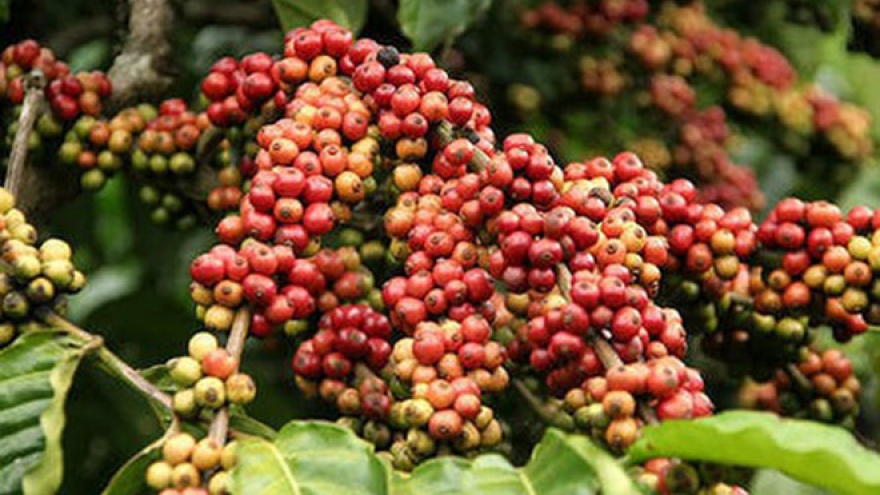Police seize fake coffee shipment in robusta king Vietnam
Environment police have seized a shipment of fake coffee at a bus station in the central town of Vinh, some 300km (186 miles) south of Hanoi.
The officers were on a routine patrol when they spotted a truck laden with 16 suspicious-looking bags, which the truck driver declared as coffee.
The bags weighed 850 kilograms (1,870 lb), but only 200kg was real coffee, while the rest turned out to be roasted soybeans soaked in chemicals and flavoring to make them look like coffee. The beans were on their way for sale in Nghe An Province from a company in the southern province of Binh Duong, the driver told police.
The catch is the latest in a series of cases involving fake coffee exposed over the past five years in Vietnam, the world's biggest robusta producer and exporter.
 |
| A police officer checks coffee bags seized from a truck in Vinh Town, Nghe An Province. Of the 850kg of so-called coffee, 650kg turned out to be roasted soybeans. |
Fake coffee has been found across the nation, which has one of the world's fastest growing retail coffee markets, trailing only behind Indonesia, Turkey and India, as reported by global market intelligence agency Mintel.
Police have also uncovered small processing plants making fake coffee by over-roasting soybeans and corn in Ho Chi Minh City, which is Vietnam's main coffee trading market, as well as in Can Tho City and provinces like Binh Duong and Thanh Hoa.
Even in Dak Lak, the country's top coffee-growing province, market inspectors have found coffee powder containing only 10% real coffee, with the majority made up of soybeans, corn and chemicals used to create the bitter taste and bubbles.
In July 2016, the Vietnam Standard and Consumers Association said it had taken 253 coffee samples from various shops in four locations, including Hanoi and Ho Chi Minh City, and found that one third of them had very low caffeine content, while the stimulant was totally absent in five samples.
The coffee sold in street-side shops, hospitals and schools tended to have very low caffeine content or no caffeine at all, the association said.
A kilogram of robusta beans now fetches around VND46,000 ($2.02), while imported soybeans can be bought on the domestic market for VND12,000-14,000 per kilo.
 |
| Real coffee beans and fake coffee made from soybeans soaked in chemicals and flavoring. |
Changing awareness
These findings by police and market inspectors have caught public attention and have changed consumer behavior.
"Consumers are now aware that fake coffee is a real problem," said Le Duc Huy, deputy general director of the Dak Lak-based Simexco, one of Vietnam's biggest exporters of semi-processed robusta beans. "Many now know how to spot fake coffee."
He said the content of real coffee sold on the market has now doubled to around 60% in the southern region and the Central Highlands coffee belt.
"But in the northern and the central regions, which lie far from the coffee processing hub, consumers may not be aware, so the coffee content there is as low as 20%-30%," Huy told VnExpress International via telephone from Dak Lak.
Improved awareness among Vietnamese coffee drinkers has been reflected in the rising domestic consumption rate in a country where tea is also a popular drink.
Vietnam is forecast to use 172,200 tons of coffee at home in the 2016/2017 crop year, up 10 percent from the previous season, the U.S. Department of Agriculture (USDA) said in its December report.
The domestic consumption rate has been rising in double digits since at least the 2012/2013 season, based on USDA data. The country's crop year lasts between October and September.
Rising exports
Higher domestic consumption, coupled with a rush to sell by exporters in the first months of 2017 and the smaller 2016/2017 harvest due to adverse weather, could disrupt coffee exports, traders said. More instant coffee being produced locally has also been contributing to the tighter export flow, Vietnamese industry officials said.
Vietnam could export an estimated 180,000 tons of coffee in March, the highest monthly shipment since April 2016, based on government data released on March 29.
Most of the shipments were sold in late January or February as exporters tried to cash in on higher prices while cutting costs, traders said. On the other hand, foreign buyers said they had stepped up purchases based on expectations of a smaller crop in Vietnam.
The March estimate has brought the country's total export volume to 847,000 tons in the first half of the 2016/2017 season, up 4% from a year ago.
Vietnam could face coffee shortages from May-June due to rising shipments and dwindling domestic stocks, top export firm Intimex has said.
Huy of Simexco said Vietnam should do more to fight fake coffee.
"The media should do its best to help consumers spot real coffee," he said. "Related agencies should also step up inspections of coffee shops because shop owners are making money by selling fake coffee as it costs up to 50% less than real coffee."



